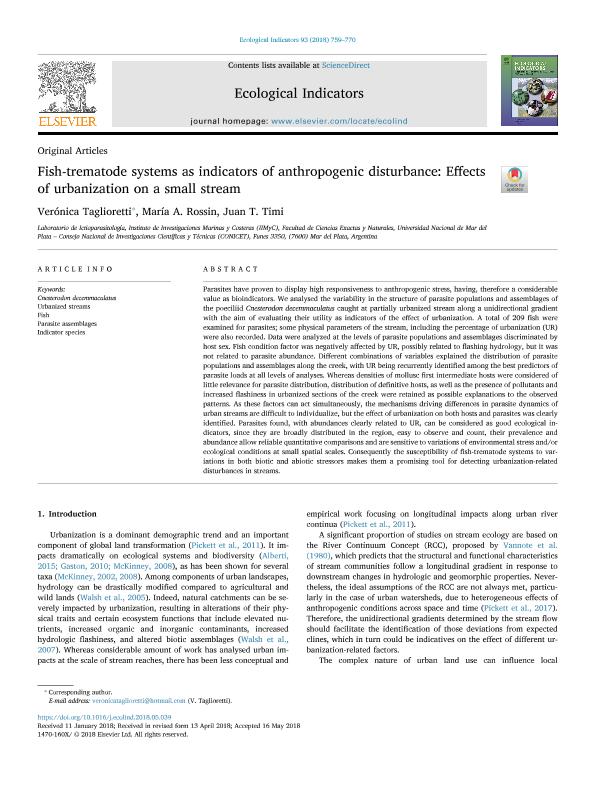Artículo
Fish-trematode systems as indicators of anthropogenic disturbance: Effects of urbanization on a small stream
Fecha de publicación:
10/2018
Editorial:
Elsevier Science
Revista:
Ecological Indicators
ISSN:
1470-160X
e-ISSN:
1872-7034
Idioma:
Inglés
Tipo de recurso:
Artículo publicado
Clasificación temática:
Resumen
Parasites have proven to display high responsiveness to anthropogenic stress, having, therefore a considerable value as bioindicators. We analysed the variability in the structure of parasite populations and assemblages of the poeciliid Cnesterodon decemmaculatus caught at partially urbanized stream along a unidirectional gradient with the aim of evaluating their utility as indicators of the effect of urbanization. A total of 209 fish were examined for parasites; some physical parameters of the stream, including the percentage of urbanization (UR) were also recorded. Data were analyzed at the levels of parasite populations and assemblages discriminated by host sex. Fish condition factor was negatively affected by UR, possibly related to flashing hydrology, but it was not related to parasite abundance. Different combinations of variables explained the distribution of parasite populations and assemblages along the creek, with UR being recurrently identified among the best predictors of parasite loads at all levels of analyses. Whereas densities of mollusc first intermediate hosts were considered of little relevance for parasite distribution, distribution of definitive hosts, as well as the presence of pollutants and increased flashiness in urbanized sections of the creek were retained as possible explanations to the observed patterns. As these factors can act simultaneously, the mechanisms driving differences in parasite dynamics of urban streams are difficult to individualize, but the effect of urbanization on both hosts and parasites was clearly identified. Parasites found, with abundances clearly related to UR, can be considered as good ecological indicators, since they are broadly distributed in the region, easy to observe and count, their prevalence and abundance allow reliable quantitative comparisons and are sensitive to variations of environmental stress and/or ecological conditions at small spatial scales. Consequently the susceptibility of fish-trematode systems to variations in both biotic and abiotic stressors makes them a promising tool for detecting urbanization-related disturbances in streams.
Archivos asociados
Licencia
Identificadores
Colecciones
Articulos(IIMYC)
Articulos de INSTITUTO DE INVESTIGACIONES MARINAS Y COSTERAS
Articulos de INSTITUTO DE INVESTIGACIONES MARINAS Y COSTERAS
Citación
Taglioretti, Verónica; Rossin, Maria Alejandra; Timi, Juan Tomas; Fish-trematode systems as indicators of anthropogenic disturbance: Effects of urbanization on a small stream; Elsevier Science; Ecological Indicators; 93; 10-2018; 759-770
Compartir
Altmétricas




